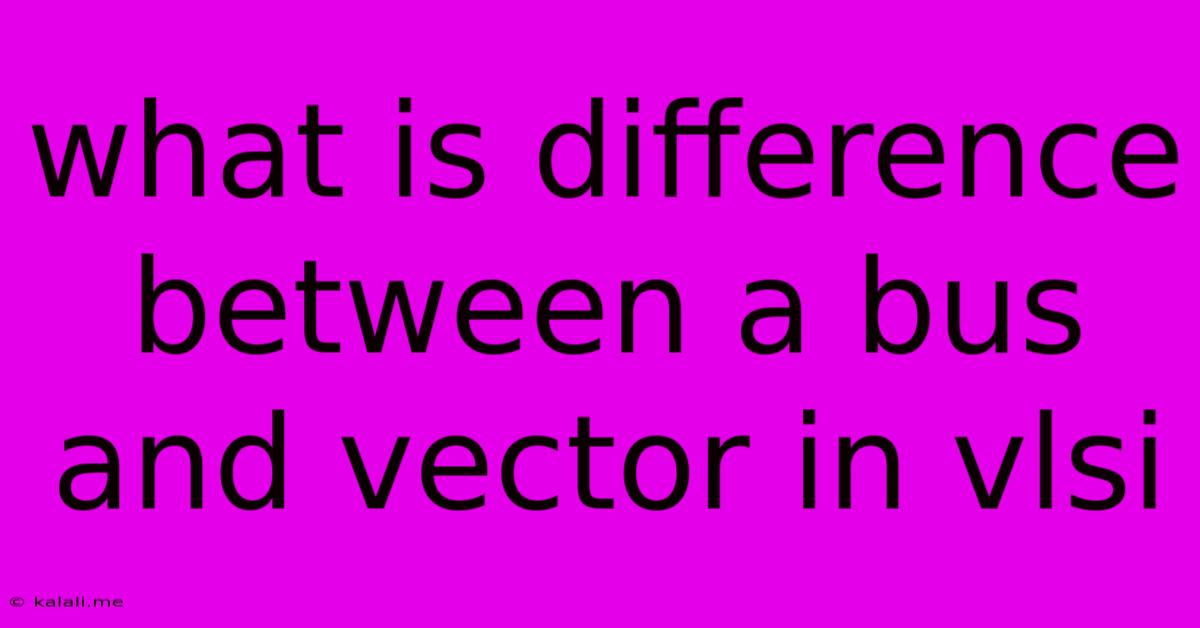What Is Difference Between A Bus And Vector In Vlsi
Kalali
May 23, 2025 · 3 min read

Table of Contents
Buses vs. Vectors in VLSI: Understanding the Key Differences
This article delves into the fundamental differences between buses and vectors in the context of Very Large-Scale Integration (VLSI) design. Understanding these distinctions is crucial for efficient and effective digital circuit design. This guide will clarify their functionalities, applications, and the contexts in which each is most suitable.
What is a Bus in VLSI?
A bus in VLSI is a collection of parallel signal lines that are used to transmit data between different components or modules within an integrated circuit. Think of it as a shared highway system for data. These lines operate synchronously, meaning they transfer data simultaneously. Buses are typically unidirectional or bidirectional, depending on their design and the specific needs of the system. They are crucial for communication within a complex VLSI chip, enabling different parts to interact and exchange information. Common examples include address buses, data buses, and control buses.
Key Characteristics of Buses:
- Parallel Data Transfer: Buses transfer multiple bits simultaneously, leading to faster data transmission compared to serial methods.
- Shared Resource: A single bus is often shared by multiple components, requiring careful arbitration to prevent data collisions.
- Multiple Lines: Composed of numerous individual signal lines, each carrying one bit of data.
- Fixed Width: The width of a bus (number of lines) is typically fixed during design, determining the maximum data size it can transfer.
- Synchronous Operation: Data transfer is synchronized with a clock signal, ensuring coordinated communication.
What is a Vector in VLSI?
In VLSI, a vector represents an ordered collection of data elements, usually bits, that are processed as a single unit. Unlike a bus, which is a physical pathway for data, a vector is a data structure. It's a way of organizing and representing data within a design, often used in algorithms and data processing units like ALUs (Arithmetic Logic Units) and DSPs (Digital Signal Processors). Vectors are manipulated using vector instructions, which perform operations on the entire vector simultaneously, leading to significant performance gains. This parallel processing capability is a key advantage of using vectors.
Key Characteristics of Vectors:
- Data Structure: A vector is a logical representation of data, not a physical pathway.
- Parallel Processing: Vector instructions allow for parallel processing of multiple data elements, enhancing computational speed.
- Variable Length: Vectors can have varying lengths, offering flexibility in data handling.
- Sequential or Parallel Processing: While often processed in parallel, vectors can also be processed sequentially, depending on the architecture and instructions used.
- Used in specialized units: Frequently employed within dedicated processing blocks, rather than for general communication like buses.
Key Differences Summarized:
| Feature | Bus | Vector |
|---|---|---|
| Nature | Physical pathway for data transfer | Data structure for data organization |
| Data Transfer | Parallel, synchronous | Parallel or sequential processing |
| Width | Fixed | Variable |
| Application | Inter-module communication | Data processing, algorithms |
| Implementation | Hardware lines | Software/hardware representation |
Conclusion:
Buses and vectors are both essential components in VLSI design, but they serve distinct purposes. Buses facilitate communication between different parts of the chip, while vectors provide a means for efficiently organizing and processing large amounts of data. Choosing between using a bus or a vector approach depends heavily on the specific requirements of the application, whether it prioritizes communication or high-speed parallel computation. Understanding these fundamental differences is vital for designing efficient and optimized VLSI systems.
Latest Posts
Latest Posts
-
If Your 35 What Year Was You Born
Jul 12, 2025
-
How Many Cups Is 1 Pound Of Cheese
Jul 12, 2025
-
30 X 30 Is How Many Square Feet
Jul 12, 2025
-
How Much Does A Half Oz Weigh
Jul 12, 2025
-
Calories In An Omelette With 3 Eggs
Jul 12, 2025
Related Post
Thank you for visiting our website which covers about What Is Difference Between A Bus And Vector In Vlsi . We hope the information provided has been useful to you. Feel free to contact us if you have any questions or need further assistance. See you next time and don't miss to bookmark.